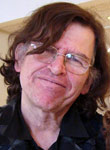World-renowned mathematician William Thurston dies at 65
By Susan Kelley

William Paul Thurston, the Jacob Gould Schurman Professor of Mathematics at Cornell and a world-renowned mathematician, died Aug. 21 in Rochester, N.Y. The cause was melanoma, which had been diagnosed a year ago. He was 65.
When Thurston joined the Cornell faculty in 2003, John Hubbard, professor of mathematics, said, "It's like hiring one of the great Nobel Prize winners." There is no Nobel Prize for mathematics, but in 1982, at age 37, Thurston won the Fields Medal, which mathematicians regard as the equivalent. He received the award for revolutionizing the study of topology in two and three dimensions, showing interplay between analysis, topology and geometry.
Topology deals with the properties of a geometric object that remain unchanged when the object is bent or stretched. For instance, a balloon is topologically the same whether it is inflated or not. In particular, Thurston worked with "manifolds." Balloons, inner tubes and skin are good approximations of a two-dimensional manifold, which can be created by taking a flat surface and bending it around until the edges can be glued together.
One of Thurston's most important works was on the classification of three-dimensional manifolds, or 3-manifolds, which can be constructed by mathematically gluing together the boundaries of a three-dimensional space. Specifically, he showed that a large class of 3-manifolds can be blown up to one particular "best shape" that would be, geometrically, a "perfect shape," with constant curvature.
"Before Thurston came around, people thought hyperbolic manifolds were very unusual," Hubbard explained in 2002. "What he showed is that a very large class of hyperbolic manifolds have this natural perfect shape."
Thurston's impact reverberated across several fields of mathematics. He discovered unexpected links between topology, hyperbolic geometry and complex analysis, and he studied relations of knot theory to computational complexity.
"The strength of [Cornell's math] department in topology is widely recognized worldwide because of Bill Thurston, who is a giant in mathematics," said math chair Laurent Saloff-Coste in May.
"He was interested in not just studying mathematics but also in connecting it to the real world, and he had a passion for making it accessible and appealing," said his son Dylan Thurston, also a mathematician.
For instance, William Thurston inspired Daina Taimina, adjunct professor mathematics at Cornell, to crochet examples of hyperbolic planes. In a foreword to her book about it, he wrote: "Many people have an impression that mathematics is an austere and formal subject concerned with complicated and ultimately confusing rules for the manipulation of numbers, symbols, and equations, rather like the preparation of a complicated income tax return. ... Good mathematics is quite opposite to this. Mathematics is an art of human understanding. ... Mathematical concepts are abstract, so it ends up that there are many different ways they can sit in our brains. A given mathematical concept might be primarily a symbolic equation, a picture, a rhythmic pattern, a short movie -- or best of all, an integrated combination of several different representations."
Thurston's awards include the 2005 American Mathematical Society (AMS) Book Prize for his book "Three-dimensional Geometry and Topology." Most recently, he won the 2012 AMS Leroy P. Steele Prize for a Seminal Contribution to Research, one of the highest distinctions in mathematics.
The son of Margaret Thurston, a homemaker, and Paul Thurston, an aeronautical engineer, William Thurston was born Oct. 30, 1946, in Washington, D.C. He graduated from New College in Sarasota, Fla., in 1967 and earned his doctorate from the University of California-Berkeley in 1972. He became an assistant professor at age 26 at the Massachusetts Institute of Technology (1973), followed by professorships at Princeton (1974-91), UC-Berkeley (1991-96) and UC-Davis (1996-2003).
Thurston is survived by his wife, Julian, his mother, two brothers, a sister, five children and two grandchildren. Memorial plans are forthcoming.
Media Contact
Get Cornell news delivered right to your inbox.
Subscribe